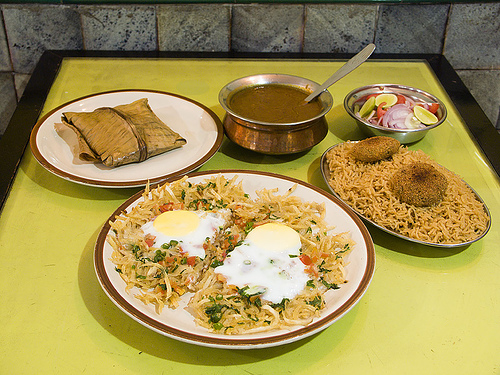The Parsi community migrated from Greater Iran to the Gujarat and Sindh between the 8th and 10th century, meaning that Parsi cuisine today is a unique amalgamation of Gujarati and non-vegetarian Persian cuisine.
The people of this community love using the spice turmeric in many of their recipes – along with saffron, it is one of their most treasured spices and is used to add depth, heat and colour to both sweet and savoury dishes. In fact, many Paris dishes use turmeric as their base ingredient, with the majority of dishes starting with the gentle frying of onions in oil with a generous amount of the spice, before other ingredients are added.

Turmeric adds a golden colour to dishes that instantly brightens them up, and it also brings a musky, peppery flavour. But it’s not just its colour and flavour that make it so popular; otherwise known as the ‘spice of life’, turmeric has also been used as a natural way of treating ailments for centuries. Healers and natural doctors throughout India have used turmeric to treat conditions such as arthritis, cuts, bruises and upset stomachs, andresearch has also confirmed that turmeric is a powerful anti-inflammatory ingredient, andhas antioxidant and antibacterial properties.
Unlike some other regions of India, the people of Parsi really like to use eggs in their cooking, livening up egg dishes with the use of turmeric to bring a fantastic yellow colour, as well as an aromatic flavour. Scrambled egg is otherwise known as ‘Akoori’ in Parsi cuisine, and is made with ghee (clarified butter), spring onions, fresh chillies, fresh ginger, chopped tomato, cumin and – of course –the well-loved spice, turmeric. Turmeric is usually added to the onions and ginger, before being combined with the eggs.
Turmeric is also used in a number of bean and lentil dishes that play an important role in Parsi cuisine. The Parsi Dhansak is one of the most famous lentil dishes to come from Parsi cuisine; it is prepared using a mixture of lentils (usually green and yellow moong dal), which are cooked with turmeric, chilli powder and tamarind paste. The Dhansak is served alongside Cachumbar – a simple, fresh salad of onion, tomato and coriander leaves.
Another popular Parsi dish that celebrates turmeric is Patra Ni Machchi: fish in a green chutney, steamed in a large banana leaf. As well as turmeric, the fish is flavoured with cumin, garlic, coconut and ginger, making a delicious paste that coats the fish before steamed it for approximately 15-20 minutes.
Parsis love turmeric so much that they even like to add it to plain boiled rice, which is then served alongside meat, vegetable or pulse dishes. Perhaps even more surprisingly, turmeric is also used in sweet Parsi dishes, from cakes to custards. One such dish a sweet golden cake, combining turmeric with semolina, dried desiccated coconut, nuts and sugar.
To experience genuine Indian food like these Parsi delicacies in the UK, head to London’s best Indian brasseries. Their food is a world away from the dishes found at your standard local curry houses, so you can get a true taste of India.